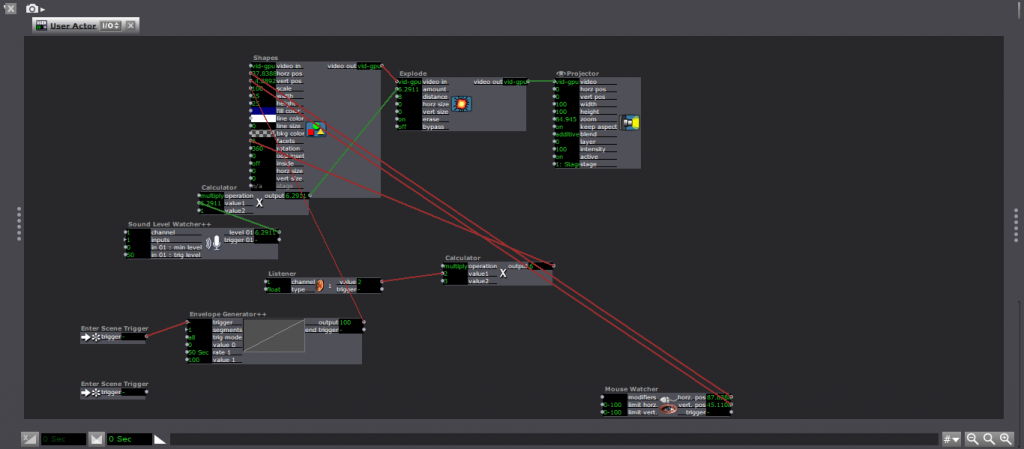BUMP: Willsplosion PP1 by Emily Craver
Posted: September 3, 2022 Filed under: Emily Craver, Pressure Project I, Tamryn McDermott | Tags: Pressure Project, Pressure Project One Leave a comment »I wanted to find a pressure project 1 to bump and take a closer look at it to inspire and give me some ideas about how to approach mine as I start contemplating ideas and directions. I was drawn to Emily’s project because she integrated both sound and an element of humor using text into the final experience. I want to use one of the text actor features in mine too. I also found some actors in her patch that I want to experiment with such as the “Explode” actor. In addition, I appreciated her organization within each scene and want to be mindful in my own work to develop an organizational system that works and keeps things clear so I don’t get lost.
Emily’s post left me wanting to see/hear the outcome. This means that when I post mine, I want to share a video of the final outcome much like Tara’s that Katie bumped. What is the best way to set up to do this? How can we export and save the content from a projector?
Willsplosion: PP 1 | Devising EMS (ohio-state.edu)
Final Mission: three travelers
Posted: December 11, 2019 Filed under: Emily Craver, Final Project | Tags: choose your own adventure, dance, Isadora Leave a comment »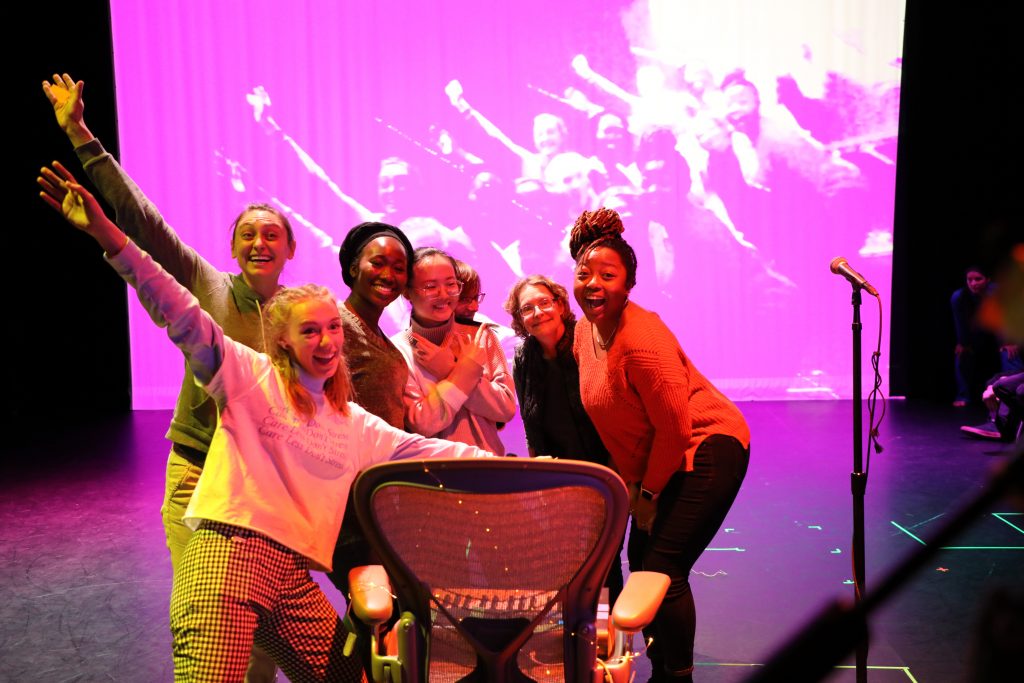
photo by Alex Oliszewski
During my Cycle 3 of Choose Your Own Adventure: Live Performance Edition, I explored how to allow for more timelines. I realized that the moments of failure for the audience provides excitement and raises the stakes of the performance. How to make a system that encourages and provides feedback for the volunteers while also challenging them?
I feel most creative and myself when creating pieces that play with stakes. I love dance and theatre that encourages heightened reactions to ridiculous situations. The roles of the three travelers started to sink in to me the more we rehearsed. They needed to be both helpless adventurers somewhere distant in time and space while also being all-knowing, somewhat questionably trustworthy narrator-like greek chorus assistants. Tara, Yildiz and I added cheering on the volunteers to blur those lines of where and who we are.
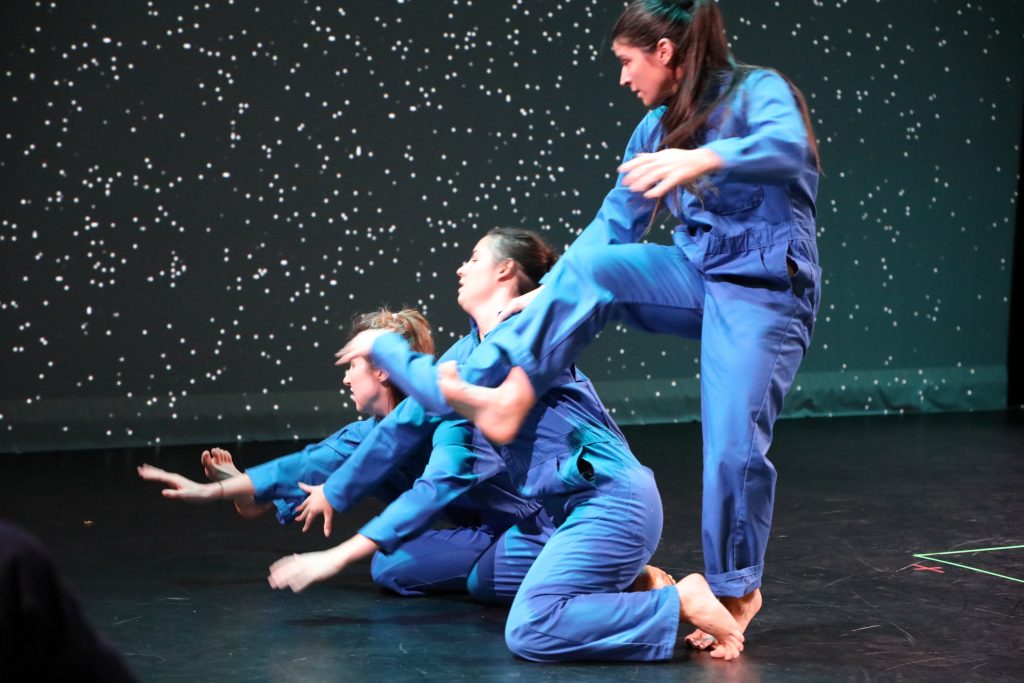
photo by Alex Oliszewski
The new system for Choose Your Own Adventure included: MIDI keyboard as a controller, Live Webcam for a live feed of adventurers and photo capture of successes, FocusRite Audio hook-up for sound input and sound level watcher, GLSL shaders of all colors and shapes, and Send MIDI show control in order to trigger light cues.
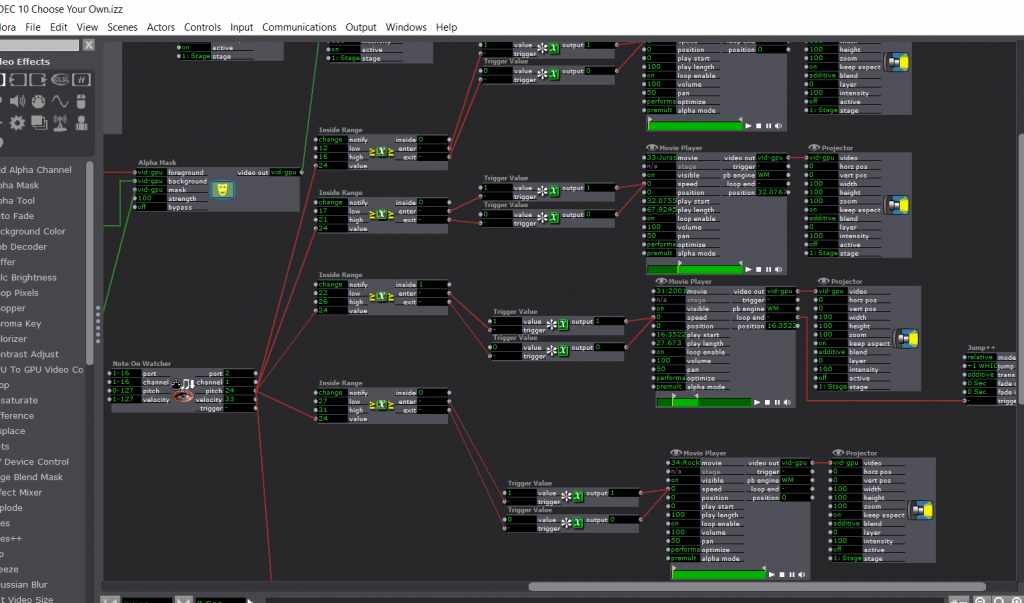
The new system provided more direct signs of sound level watching and cues to the volunteers. The voice overs were louder and aided by flashing text reiterating what the audience should be doing. The three travelers became side coaches for the volunteers as well as self-aware performers trying to gain trust. I found myself fully comfortable with the way the volunteers were being taken care of and started to question and wonder about the audience who was observing all of this. How can an audience be let in while others are physically engaging with the material? I thought about perhaps close camera work of the decisions being made at the keyboard? Earlier suggestions (shout out to Alex Christmas who gave this suggestion) included an applause-o-meter to allow for the non-volunteers to have a say from their seats. A “Who Wants to be a Millionaire” style audience interaction comes to mind with options for volunteers to choose how to interact and have the audience come to their aid. What does giving audience a voice look like? How can it be both respectful, careful and challenging?


Cycle 2: Choose your own Adventure
Posted: December 1, 2019 Filed under: Emily Craver, Uncategorized Leave a comment »Cycle 2 of my Mission to Mars developed multiple endings and the switchover to a slightly new narrative. Upon discovering that Mission to Mars is actually a Disney Theme park ride-turned film, funny enough, I decided to switch the story. There is now a three person mission that has gone astray and it is up to the volunteers from the audience to find them. Are they rogue? Are they lost? Are they being sabotaged?
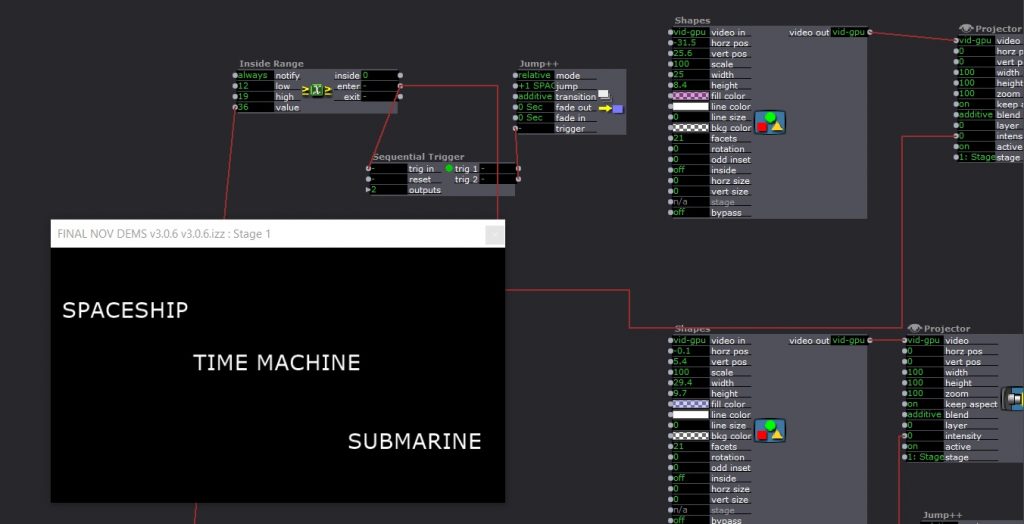
This particular crew chose TIME MACHINE which sent them into journey to who knows what time, accompanied by this GLSL shader and Cyndi Lauper’s sweet voice.
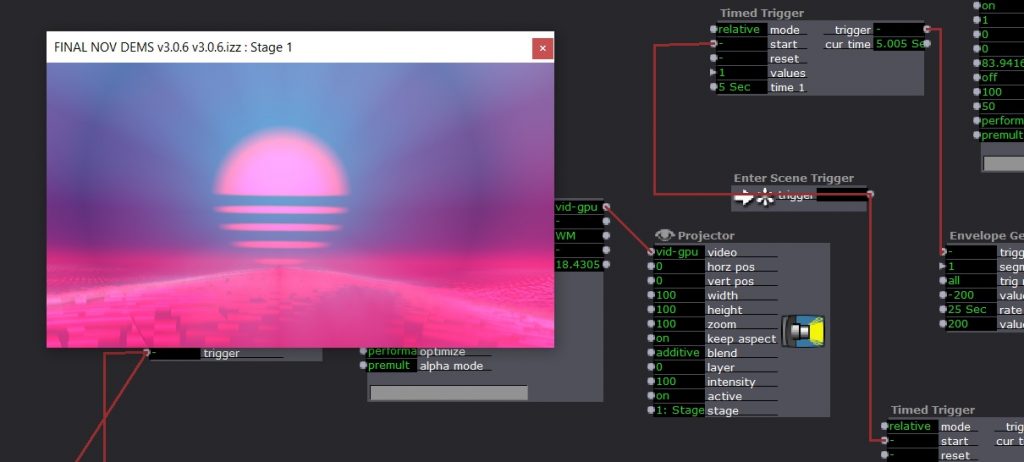
RUN-DOWN of the piece for the PERFORMERS:
LAYOUT of CYCLE 2 CHOREO scenePRESHOW set in three corners of space in chair pathways television and basket preset scenePREAMBLE music starts//text onscreens EM TARA YILDIZ enter from three corners {5 walks getting excited 2 walks trepidatious 2 walks back track 3 walks into trio Slice Phrase} slice/insert/round head/press down 2, 3 3 rotations charging up/dev/kick thru pas de chat/swoop down/walk out legs try to hug/double slap/fail drone faces phrase glob together fancy legs with head going straight frwd, down Left angle, Up above Then look out to audience above heads Realize something wrong//we share something together//a secret} go to Basket and pull three strings to bring basket to center we lay down the strings and walk away from whence we came sceneSTARYAY audience volunteers and cheers sceneFIRST SCENE V.O. Intro sceneTITLES assigned names for players//descriptions out in the space sceneWHICH PATH audience decides how to go sceneSPACESHIP or TIME MACHINE or SUBMARINE text scroll and transition to decide which noise to pick who will volunteers sceneSOUND WATCHER audience picks a sound for the microphone to pick which character will interact with the hologram sceneHOLOGRAMZ TaraEmYildiz run into center light facing the volunteer who won: movement phrase: M with our bodies (Yildi in middle, Tara Em make the slants down) pick up the phone lost connection, hang it up with body– up and down up down and around FACE THE PERSON AND NOD dissipate sceneYOU V.O. Find the light in the vehicle to find out who will volunteer sceneVOLUNTEER instructions sceneHYPOTHESIS flashlight decision sceneMARS or IN THE HOLLOW EARTH or AT THE MALL we celebrate and explain our body language from the hologram: YOU DID IT!!! yayyy MARS: We were approaching Mars when we lost contact with our base and the turbulence was up and down until we crash landed HOLLOW EARTH: We were on a Mission to the North Pole when we lost contact with our base and as we flew over the pole we were sucked into the hollow earth AT THE MALL: Meet you at the MALL, I’m so glad you Called, we went Up and Down Up Down and Around.
Next Cycle will include ways to fail, ways to return to previous sections to make a new decision, a MIDI keyboard that will allow for an easier interaction with the system, and potentially more interaction by the live performers.
Mission 2: Cycle 1
Posted: November 5, 2019 Filed under: Emily Craver Leave a comment »
It is a rare and wonderful gift to perform a piece again and again as you build. I’m so used to slamming a piece together and allowing for the spontaneity to provide some additional content.
For cycle 1, I took my Mars Mission Murder Mystery and altered it into the beginnings of a live performance/interactive adventure. This means that in addition to the exciting possibilities of the technology available within this course, there is then also the overwhelming possibilities of live performance interaction. Additionally, what are the needs in terms of story-telling within an interactive performance? Similar to a choose your own adventure story/Black Mirror Bandersnatch situation, will the narrative suffer is the interactivity lies at the center of the maker’s proorities?
Cycle 1 saw an added preamble in which my live performers will be introduced as four space travellers//in this rendition, I performed as the unit. There was also an addition of a piece of paper on a string sliding across the stage asking PLEASE READ ME. Playing with both analog and digital//tangible and programmed interests me in this project.
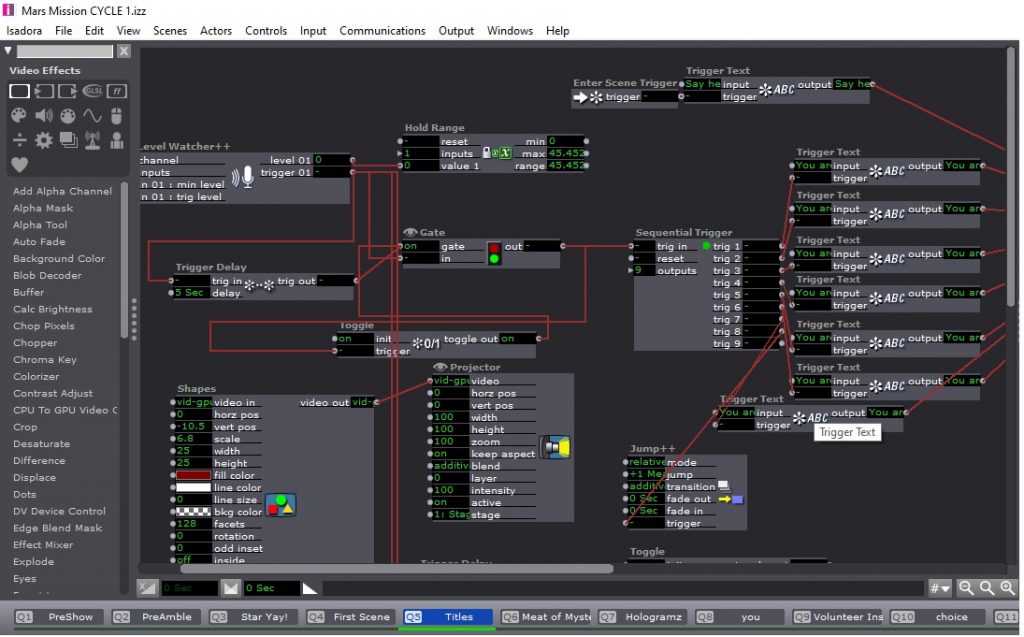
With the addition of a gate, trigger delay, and toggle, as well as a connected shapes actor, the character choice section became slightly more accurate. My audience participants afterward had lovely suggestions relating to perhaps finding space to play within these characters. How are they related? What are their jobs? Is there an interactive game that could bring them all together/tear them apart?
A live pretend hologram then warns the players that things are not as they seem. A random actor chooses a spotlight in order to pick a human to act as representative. This person then must choose how to continue. Should you look at a scene from the travellers’ past, present, or future?

murder on the mission to mars
Posted: October 20, 2019 Filed under: Emily Craver, Pressure Project 3 1 Comment »My immediate thought as to what to create on our third Pressure Project involving mystery was Murder Mystery Party and the Clue Movie. Should I randomize three minutes worth of clips from the movie as a guessing game? Can I assign people to be the characters and initiate a Live Action Re-staging of the movie? Then I realized that I might as well create my own mystery: a mystery on a mission to mars.
Excited to explore lighting elements through a Send Midi Show Controller as well as how to assign characters in real-time via a sound level watcher and inside range actor, I created a four-scene interactive experience in which the audience acts as first adventurers en route to Mars–interrupted by murder. The three-minute time limit acted as prevention from creating an entire narrative delving into these characters, but also creates an interested set-up for the audience. Mars seems to be the focus until the story shifts. I’m interested in creating more of the context around why/who/how and feedback from my classmates implied that there was some curiosity around details.
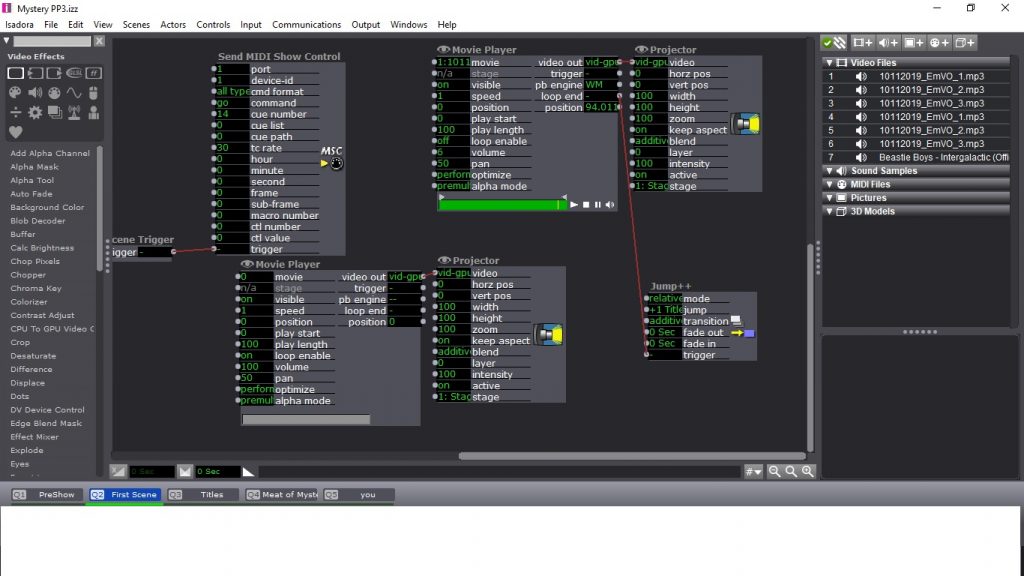
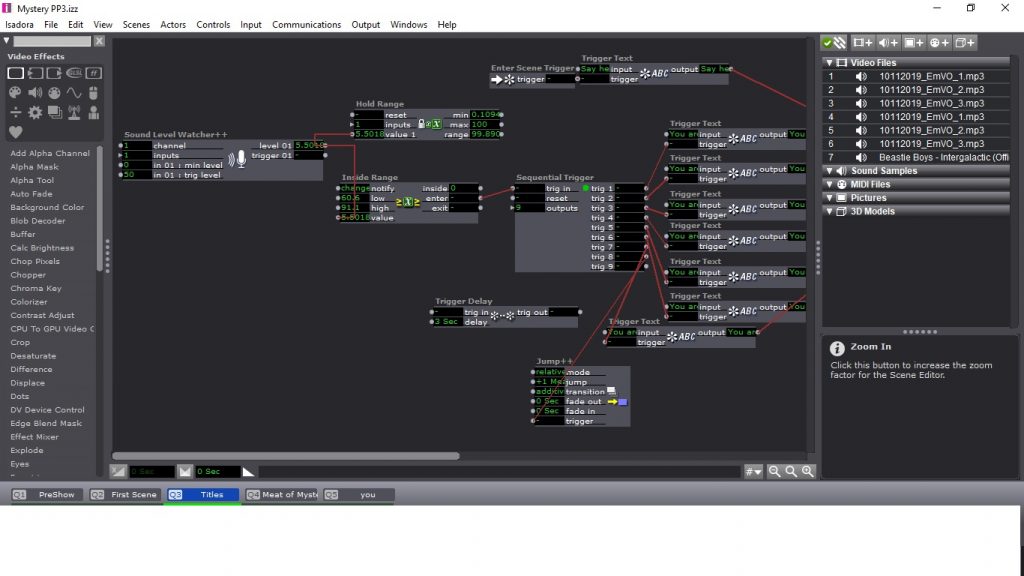
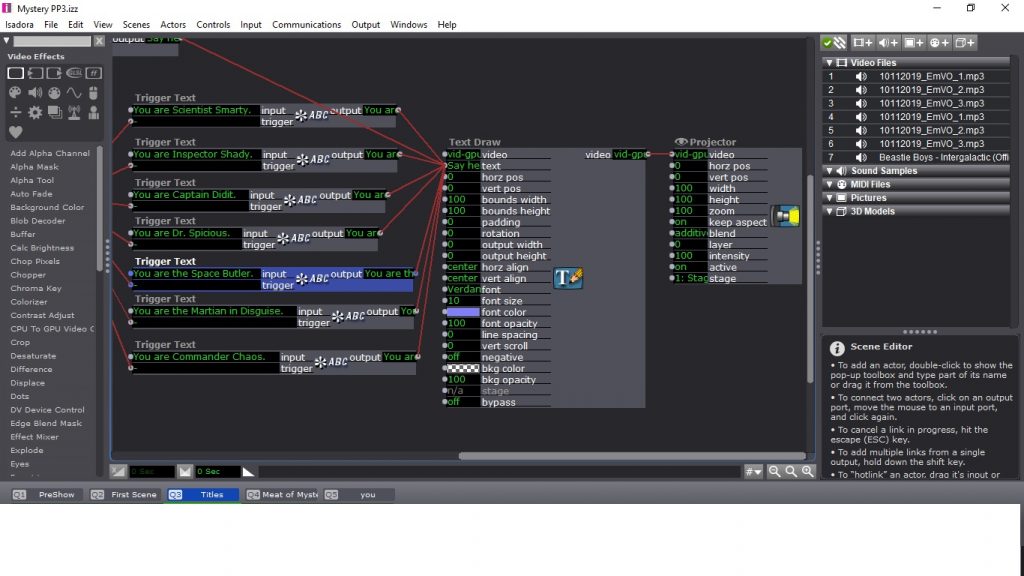
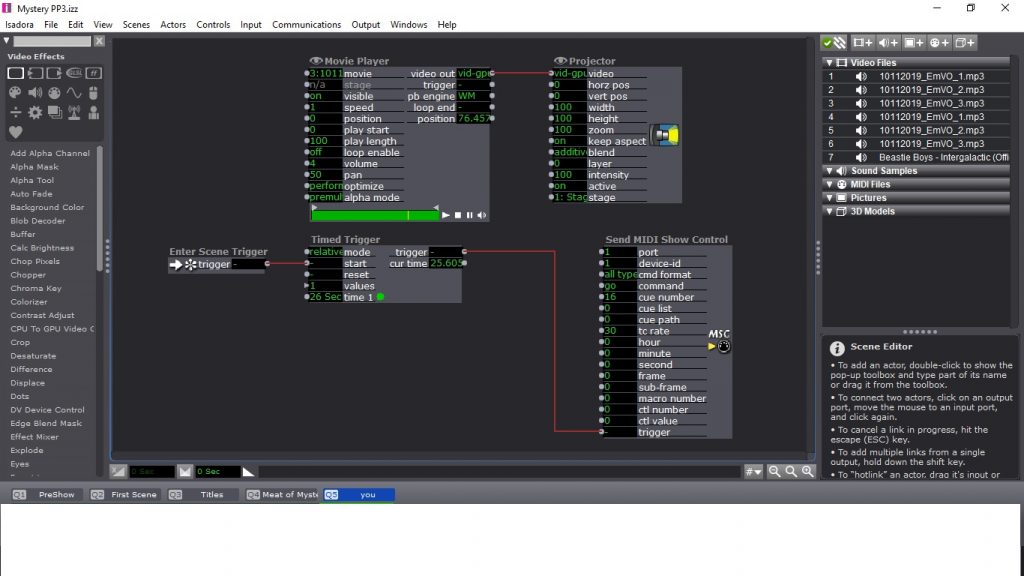
worlds of wars: Pressure Project 2
Posted: September 28, 2019 Filed under: Emily Craver, Pressure Project 2 Leave a comment »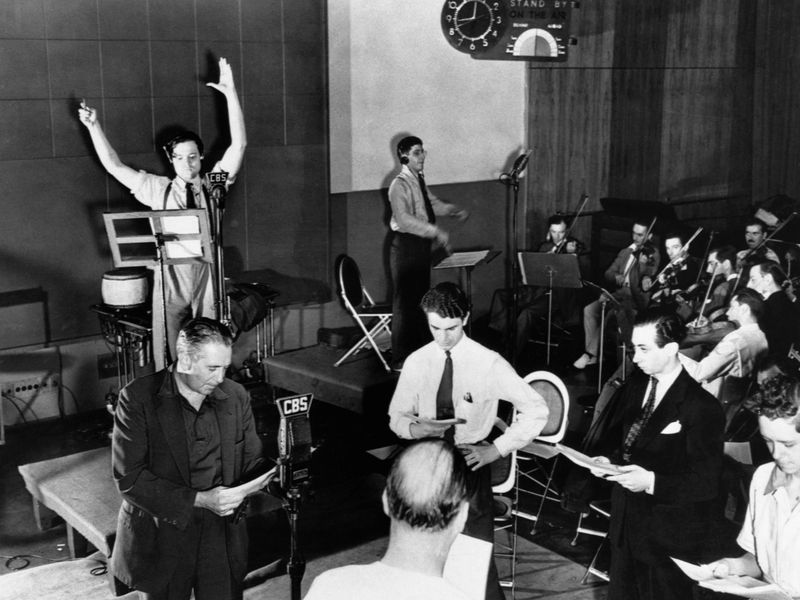
A story told through sound alone. When thinking about how to tell a story, I meditated on the idea of context around the story, cultural and historical. How to include the feeling of the story without just telling? How to include the emotional environment without just telling? The idea of a story that is both fictional and influential and a capsule of time lead me to Orson Welles’ War of the Worlds (a retelling of H.G.Wells’ War of the Worlds). The myth around this story is greater than the actual story.
The layers of the hoax run deep. First off, my own knowledge of the story led me to believe that mass panic ensued surrounding the radio broadcast of War of the Worlds, when in fact the panic was largely media-led (specifically the response of newspaper media).
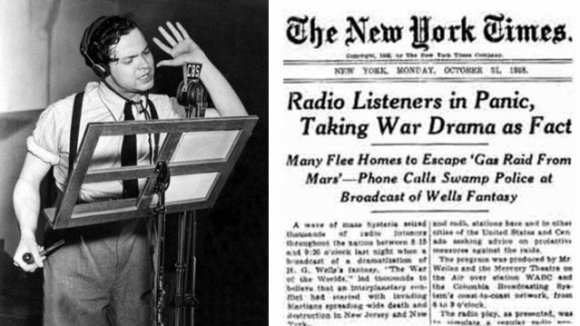
Purposeful fake news around purposeful fictionalized fake media.
I then fell into the rabbit hole of 1938 radio. Somehow in my knowledge of this broadcast, I had always pictured panic of alien invasion without ever contextualizing the fact that invasions were indeed occurring; that within the historical context of the U.S. (as well as what was about to be the “European Theatre of WW2), drastic things were erupting. I found a 1938 Charles Lindbergh speech in which an extremely rowdy crowd responded to his jeering and raucous blame of war on three powers: Roosevelt administration, the Jewish people, and Great Britain. The reverberations of the dangers of a mob of people chanting, cheering and angrily jeering can be felt today. Echoed today in rallies, in bombastic political hatred and bigotry, similar sentiments and rhetoric continue to fuel what it means to live in America.
And then there is the absolute gold mine that is radio theater–the compression of live soundmaking into soundwaves that will reach humans gathered around the radio ready for fireside chats and thrilling Orson Welles tales.
Reflecting on the idea of trust/dependency on radio as primary immediate news source, the power structures in place to guarantee only one type of voice to be heard across all radio waves, and the difference in the flood of outlets available to sift through today.
Willsplosion: PP 1
Posted: September 15, 2019 Filed under: Emily Craver, Pressure Project I Leave a comment »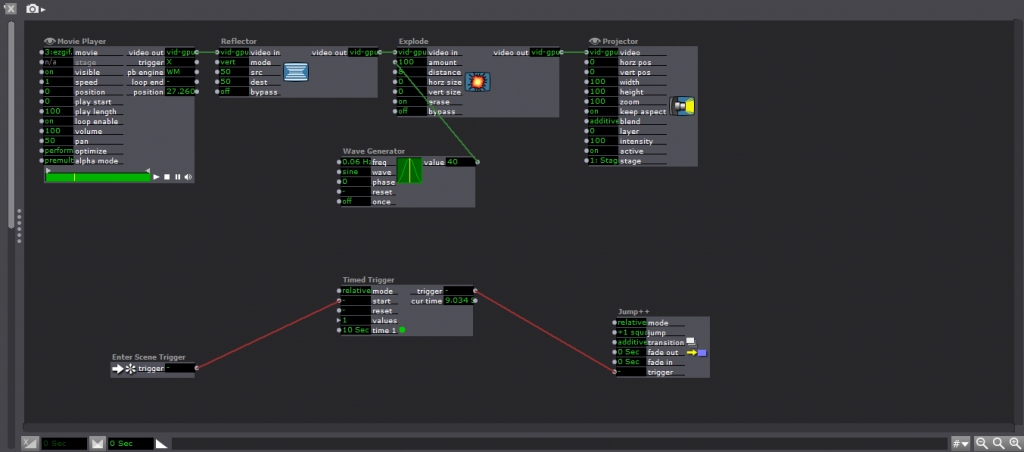
Four hours feels so short and yet so long. This project helped me realize my own sense of time in connection to creation and in connection to completing assignments. I rarely notice the amount of time I take while completing an assignment. Especially when it comes to being on the computer and Isadora, a land of play, time tends to separate from task.
This time, though, I felt the rush of the ticking clock. I worked with an urgency that allowed for a generation of material and an acceptance of each idea I had as the idea with which I would go. I started with a simple shape with wave generators affecting the line size of the two colors within the shape, the rotation of the shape, and the number of facets, or actual shape of said shape. The other part of the four hours of this project forced me to use resources at hand, music downloaded on my computer. I then added a time trigger to begin Shapes by The Kinks. Triggered Jump to next scene where a new collection of shapes–similar color palette but the shapes have all separated: an expansion of the previous scene.

Because of the humor element and the framing of interactivity that the course has, I wanted the watcher to notice their own self within the space. In another patch with more time, I would add a live capture element where the audience members face may appear//offering an implication of surveillance and performativity within the viewer. But for now, I used the text “oh hello there”. First humor idea included a gif of someone (Will Ferrell) turning around “I didn’t see you”, therefore, that is the idea I used.
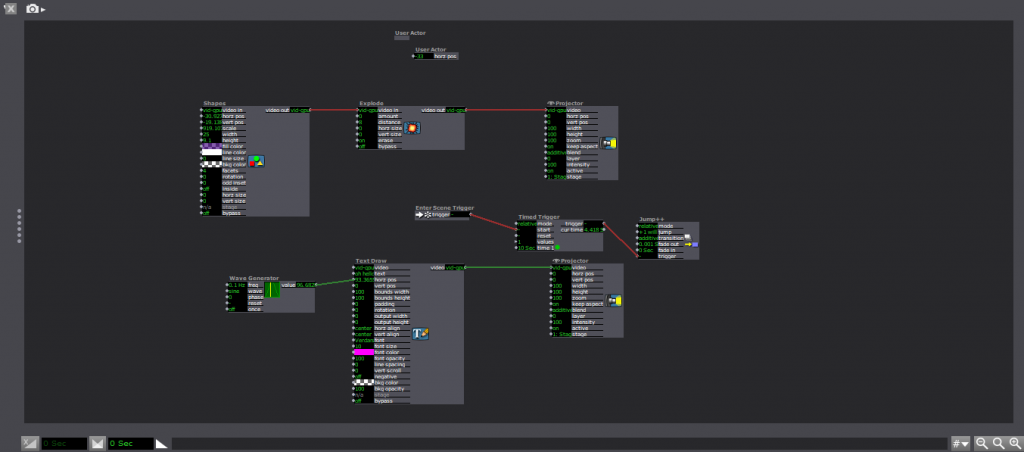
i didn’t see you
The truly interesting moments were within the critique noticing the way timing and patterning of the patch created expectation within the audience. How to both lull the audience into a safe, enjoyable space that they can sit in, while also surprising and delighting? The idea of anticipations and expectations being created and then manipulated applies both to comedy and interactive systems.
